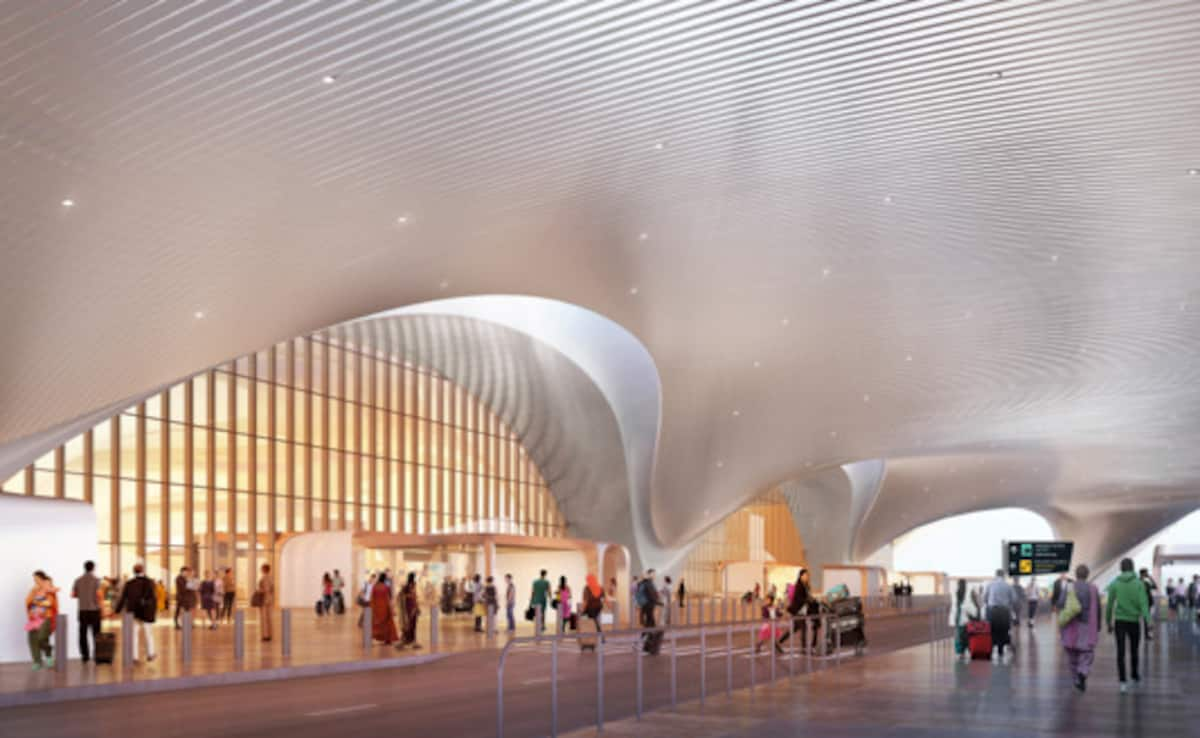
Navi Mumbai International Airport (NMIA) is poised to open by September 30, 2025, marking a major new chapter in Mumbai's aviation sector. Work on the project is about 94% complete, with authorities pushing to finish interior and exterior finishing, baggage systems, runway work and supporting infrastructure. When operational, NMIA will begin with its first terminal handling approximately 20 million passengers per annum, with scope to scale up over time. The goal is for it to be a well-connected international airport that relieves pressure on Mumbai's existing airport and offers more choices for travellers. Here's what you should know about it:
Structure Of Navi Mumbai International Airport
NMIA is being built over roughly 1,160 hectares, making it larger in area than Mumbai's current main airport in Andheri-Santacruz (Chhatrapati Shivaji Maharaj International Airport or CSMIA). Its overall design is inspired by the lotus flower. It is also characterised by flowing motifs, natural light, and sustainability features.
In its first phase, NMIA will have one terminal (Terminal 1) for handling both domestic and international traffic. Its capacity will be around 20 million passengers per annum. The airport's runway will be around 3,700 meters long. As the project progresses through phases, there are plans for up to four terminals and two parallel runways, bringing full capacity to about 90 million passengers per year.
Passenger Amenities At Navi Mumbai International Airport

NMIA is being equipped with a number of passenger-friendly features:
- A fast baggage-handling and claim system
- Modern check-in zones, security screening with streamlined flow, likely including automated or biometric features.
- Lounges, food courts, retail zones, both local and international, and waiting spaces designed for comfort.
- Emphasis on sustainability through green electricity (including solar generation), efficient energy use, etc.
Also Read: Noida International Airport To Begin Operations By Late 2025, Targets 6 Million Passengers
Navi Mumbai International Airport: Location And Connectivity
Road Connectivity To Navi Mumbai International Airport
NMIA is located in Ulwe, near Panvel. It will be accessible via multiple major routes:
- Mumbai Trans Harbour Link (MTHL) (Atal Setu) connecting Sewri in South Mumbai to Navi Mumbai. It will help reduce travel time from South Mumbai to Ulwe significantly.
- The Sion-Panvel Highway, Eastern Freeway, and connecting roads through Vashi, Nerul, Belapur, etc.
- A new elevated corridor is being planned between Thane and NMIA to further cut commuting time.
- Dedicated airport express buses from major hubs (Pune, Thane, Dadar, Vashi, Panvel, etc.) are part of the planning.

Navi Mumbai International Airport can be reached by road and rail. Photo Credit: nmiairport.co.in
Rail Connectivity To Navi Mumbai International Airport
- Panvel station, an existing suburban rail/intercity hub, will be important for passengers coming from further away, transferring via other modes to NMIA.
- Surveys have been approved for short elevated/stilted rail links connecting NMIA to Khandeshwar station (on Harbour line) and Targhar station (on the Port/Nerul-Uran line).
- Metro connections are planned: for example, Metro Line 8 (connecting CSMIA to NMIA) and other lines or extensions to link the surrounding suburbs.
Management Of Navi Mumbai International Airport
NMIA is being developed by Adani Group via its airport subsidiary (Adani Airport Holdings / NMIAL), as a greenfield airport. The project involves collaboration with state government authorities for land, connectivity, and planning.
Adani Airports has introduced a set of digital platforms ahead of NMIA's opening, aiming to make travel more seamless. One of the key tools is aviio: a smart-airport operations system to coordinate among airlines, security, ground handling and regulators. There's also the Adani OneApp, which is a unified app for live flight updates, lounge or parking bookings, retail or food purchases. Finally, there's Airport in a Box, which is a modular service offering for airports that streamlines the deployment of digital infrastructure.
Also Read: Do You Know Where India's Largest Airport Is? Find Out What Makes It Unique
Navi Mumbai International Airport: Possible Benefits For Travellers
For people travelling to or from Mumbai, NMIA could provide several benefits:
- Reduced congestion at the current Mumbai airport (CSMIA): With NMIA handling increasing volumes, some flights and traffic will shift away, potentially freeing up capacity and easing delay pressures.
- More route & schedule choices: As NMIA starts operations and phases advance, airlines are likely to add new domestic and international routes, giving travellers more flexibility in timing and destinations.
- Better access for suburbs/Navi Mumbai region: Residents of Ulwe, Panvel, Kharghar, etc. will have a closer airport option, reducing travel time otherwise spent going into, through or around central Mumbai.
- Improved multimodal connectivity makes transit more reliable: with road, metro, rail, and bus options in development, arriving at or leaving from NMIA should become more predictable.
Navi Mumbai International Airport: What To Expect In The Coming Months
Two carriers (IndiGo and Akasa Air) are already confirmed to start flights from NMIA once it opens. As per reports, IndiGo will launch with about 18 daily flights to more than 15 domestic cities and expects to scale up by March 2026 to include international routes. According to reports, Akasa Air plans an initial schedule of 100+ weekly domestic departures from NMIA, later scaling up by November 2026. Terminal 2 and additional phases (Terminals 3 & 4, second runway) will roll out over future years; Terminal 2 is expected around FY 2028-29.
Navi Mumbai International Airport is shaping up to be a defining project for the region. Travellers can look forward to a modern terminal, more route choices, and better connectivity over time. While some amenities and transport links will unfold gradually, NMIA promises to reduce strain on the existing airport. For now, travellers should keep an eye out for which services will become active soon and plan their journeys accordingly.
Track Latest News Live on NDTV.com and get news updates from India and around the world

